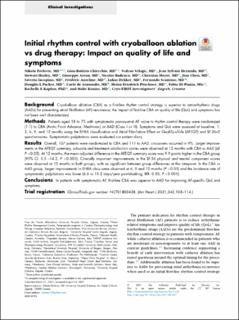| dc.contributor.author | Pavlovic, Nikola | |
| dc.contributor.author | Chierchia, Gian-Battista | |
| dc.contributor.author | Velagic, Vedran | |
| dc.contributor.author | Hermida, Jean Sylvain | |
| dc.contributor.author | Healey, Stewart | |
| dc.contributor.author | Arena, Giuseppe | |
| dc.contributor.author | Badenco, Nicolas | |
| dc.contributor.author | Meyer, Christian | |
| dc.contributor.author | Chen, Jian | |
| dc.contributor.author | Iacopino, Saverio | |
| dc.contributor.author | Anselme, Frédéric | |
| dc.contributor.author | Dekker, Lukas | |
| dc.contributor.author | Scazzuso, Fernando | |
| dc.contributor.author | Packer, Douglas L. | |
| dc.contributor.author | de Asmundis, Carlo | |
| dc.contributor.author | Pitschner, Heinz-Friedrich | |
| dc.contributor.author | Piazza, Fabio Di | |
| dc.contributor.author | Kaplon, Rachelle E. | |
| dc.contributor.author | Kuniss, Malte | |
| dc.date.accessioned | 2022-04-19T13:26:37Z | |
| dc.date.available | 2022-04-19T13:26:37Z | |
| dc.date.created | 2022-02-18T17:13:03Z | |
| dc.date.issued | 2021 | |
| dc.identifier.issn | 0002-8703 | |
| dc.identifier.uri | https://hdl.handle.net/11250/2991364 | |
| dc.description.abstract | Background
Cryoballoon ablation (CBA) as a first-line rhythm control strategy is superior to antiarrhythmic drugs (AADs) for preventing atrial fibrillation (AF) recurrence; the impact of first-line CBA on quality of life (QoL) and symptoms has not been well characterized.
Methods
Patients aged 18 to 75 with symptomatic paroxysmal AF naïve to rhythm control therapy were randomized (1:1) to CBA (Arctic Front Advance, Medtronic) or AAD (Class I or III). Symptoms and QoL were assessed at baseline, 1, 3, 6, 9, and 12 months using the EHRA classification and Atrial Fibrillation Effect on QualiTy-of-Life (AFEQT) and SF-36v2 questionnaires. Symptomatic palpitations were evaluated via patient diary.
Results
Overall, 107 patients were randomized to CBA and 111 to AAD; crossovers occurred in 9%. Larger improvements in the AFEQT summary, subscale and treatment satisfaction scores were observed at 12 months with CBA vs AAD (all P <0.05). At 12 months, the mean adjusted difference in the AFEQT summary score was 9.9 points higher in the CBA group (95% CI: 5.5 –14.2, P <0.001). Clinically important improvements in the SF-36 physical and mental component scores were observed at 12 months in both groups, with no significant between group differences at this timepoint. In the CBA vs AAD group, larger improvements in EHRA class were observed at 6, 9 and 12 months (P <0.05) and the incidence rate of symptomatic palpitations was lower (4.6 vs 15.2 days/year post-blanking; IRR: 0.30, P <0.001).
Conclusions
In patients with symptomatic AF, first-line CBA was superior to AAD for improving AF-specific QoL and symptoms. | en_US |
| dc.language.iso | eng | en_US |
| dc.publisher | Elsevier | en_US |
| dc.rights | Navngivelse 4.0 Internasjonal | * |
| dc.rights.uri | http://creativecommons.org/licenses/by/4.0/deed.no | * |
| dc.title | Initial rhythm control with cryoballoon ablation vs drug therapy: Impact on quality of life and symptoms | en_US |
| dc.type | Journal article | en_US |
| dc.type | Peer reviewed | en_US |
| dc.description.version | publishedVersion | en_US |
| dc.rights.holder | Copyright 2021 The Author(s) | en_US |
| cristin.ispublished | true | |
| cristin.fulltext | original | |
| cristin.qualitycode | 1 | |
| dc.identifier.doi | 10.1016/j.ahj.2021.08.007 | |
| dc.identifier.cristin | 2003527 | |
| dc.source.journal | American Heart Journal | en_US |
| dc.source.pagenumber | 103-114 | en_US |
| dc.identifier.citation | American Heart Journal. 2021, 242, 103-114. | en_US |
| dc.source.volume | 242 | en_US |

